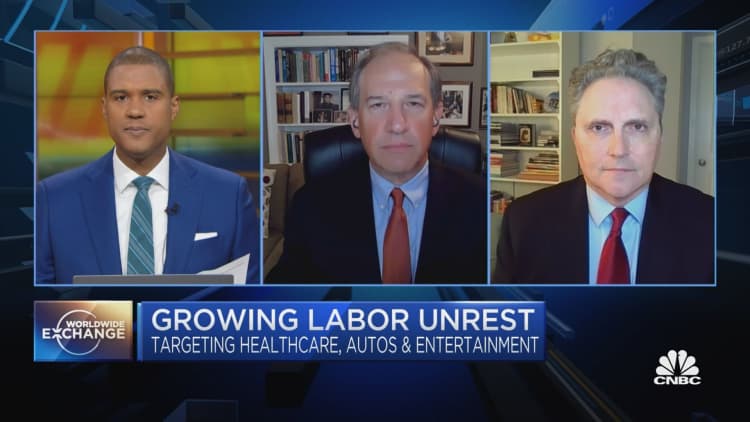Employees picket and rally at Kaiser Permanente Los Angeles Medical Center on Oct. 4, 2023.
Irfan Khan | Los Angeles Times | Getty Images
Just as Hollywood’s writers and studios reached a tentative deal to return to work after nearly 150 days, a new strike was brewing.
More than 75,000 health-care workers walked off the job Wednesday at Kaiser Permanente, the nation’s largest non-profit health-care organization, driven in part by demands for higher pay in the midst of staffing shortages, which left employees burned out.
At the same time, the United Auto Workers strike is ongoing, marking three weeks since the first-ever simultaneous walk out against the Detroit Three.
More from Personal Finance:
60% of Americans are still living paycheck to paycheck
Money market funds vs high-yield savings accounts
The job market is strong, economists say — workers don’t think so
Altogether, there have been 312 strikes involving roughly 453,000 workers so far in 2023, compared with 180 strikes involving 43,700 workers over the same period two years ago, according to data by Johnnie Kallas, a PhD candidate at Cornell University’s School of Industrial and Labor Relations, and the project director of the ILR Labor Action Tracker.
“This is a pretty considerable uptick relative to the rest of the 21st century,” Kallas said.
In the last few months alone, striking or threatening to strike has led to a string of labor deals where UPS drivers, airline pilots and aerospace manufacturing employees have pushed for and won higher pay. With each successful outcome, other labor actions are more likely to follow, Kallas said. “Strikes can often be contagious.”
‘Workers want higher pay’ amid inflation
“The strikes are an indication that workers want higher pay,” said Diana Furchtgott-Roth, an economics professor at George Washington University and former chief economist at the U.S. Department of Labor. “That’s because of the pressures of inflation.”
In the wake of the pandemic, higher prices have weighed on worker paychecks. Real average hourly earnings fell 2% over the last two years, according to the Labor Department.
As a result, purchasing power has declined and consumers have less left over at the end of the month for savings — “they both take a hit when you have less income,” said Tomas Philipson, a professor of public policy studies at the University of Chicago and former acting chair of the White House Council of Economic Advisers. “It’s concerning for people’s standard of living.”
Pandemic spurred other contract concerns
But there are other issues beyond compensation causing workers to walk out on the job, despite the potential consequences.
“Pay is a big issue but it’s not the only issue,” Kallas said. Other top concerns include staffing, retirement benefits, health care and health and safety, research shows.
“For many of these workers, especially in unionized settings, it’s the first contract they’ve negotiated since the beginning of the pandemic,” Kallas said.
In most cases, collective bargaining agreements are locked in for several years. Coming out of Covid, workers are feeling increasingly strained while watching their wages lag inflation and this is an opportunity to improve the terms, he said.
“A lot has changed.”
Subscribe to CNBC on YouTube.
Credit: Source link




